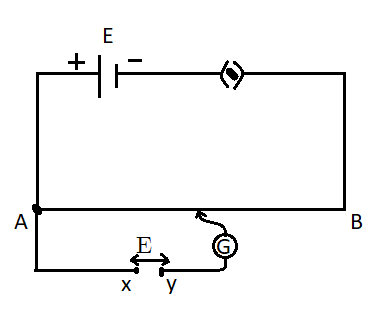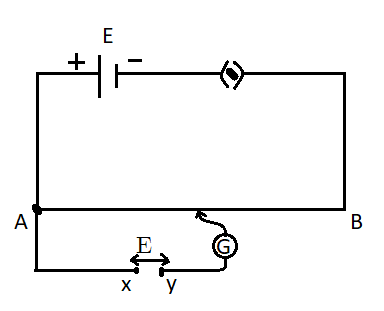Answer
405.3k+ views
Hint: We know that galvanometer is used to measure the amount of current and voltage. In the given question, we are using a galvanometer with the potentiometer to indicate the null deflection point. We will assume the point of contact of the probe of the galvanometer with the potentiometer and then to find the null point, we will compare the potential at the point of contact to the emf given.
Complete step by step solution:

In the above potentiometer circuit, the unknown emf E is connected between X and Y and the jockey of the galvanometer is moved from point A to B.
Let us assume a point C where the probe of the galvanometer touches the wire.
When the potential ${E_{ac}}$ is equal and opposite of the emf \[{E'}\] , the galvanometer reading will be zero which means it will show the null point.
For null point, the two main conditions are:
The positive terminal of the unknown emf which is given to be \[{E'}\] must be connected to X terminal.
${E'} \leqslant E$ as ${E_{ac}} \leqslant {E_{ab}} = E$
The galvanometer will never show a null point if any of the above conditions is not satisfied.
Now, let us take the errors and compare the deflections at A and B.
If we violate the first condition which means if the positive terminal of unknown emf is connected to the Y terminal, then the net potential that the galvanometer will show is $\left( {{E_{ac}} + {E'}} \right)$ .
Due to this, the net potential or deflection in the galvanometer will be maximum which means the point B will give more reading.
Now, if we violate the second condition then ${E'} \geqslant E$ and the net potential across galvanometer will be $\left( {{E'} - {E_{ac}}} \right)$ . This will be maximum, when ${E_{ac}} = 0$ . It shows that point A will give more reading.
Note: In a potentiometer circuit when a galvanometer is used, it must satisfy the above two conditions, so that the galvanometer can show a null point. The net potential must be calculated to compare it with the unknown emf.
Complete step by step solution:

In the above potentiometer circuit, the unknown emf E is connected between X and Y and the jockey of the galvanometer is moved from point A to B.
Let us assume a point C where the probe of the galvanometer touches the wire.
When the potential ${E_{ac}}$ is equal and opposite of the emf \[{E'}\] , the galvanometer reading will be zero which means it will show the null point.
For null point, the two main conditions are:
The positive terminal of the unknown emf which is given to be \[{E'}\] must be connected to X terminal.
${E'} \leqslant E$ as ${E_{ac}} \leqslant {E_{ab}} = E$
The galvanometer will never show a null point if any of the above conditions is not satisfied.
Now, let us take the errors and compare the deflections at A and B.
If we violate the first condition which means if the positive terminal of unknown emf is connected to the Y terminal, then the net potential that the galvanometer will show is $\left( {{E_{ac}} + {E'}} \right)$ .
Due to this, the net potential or deflection in the galvanometer will be maximum which means the point B will give more reading.
Now, if we violate the second condition then ${E'} \geqslant E$ and the net potential across galvanometer will be $\left( {{E'} - {E_{ac}}} \right)$ . This will be maximum, when ${E_{ac}} = 0$ . It shows that point A will give more reading.
Note: In a potentiometer circuit when a galvanometer is used, it must satisfy the above two conditions, so that the galvanometer can show a null point. The net potential must be calculated to compare it with the unknown emf.
Recently Updated Pages
How many sigma and pi bonds are present in HCequiv class 11 chemistry CBSE

Why Are Noble Gases NonReactive class 11 chemistry CBSE

Let X and Y be the sets of all positive divisors of class 11 maths CBSE

Let x and y be 2 real numbers which satisfy the equations class 11 maths CBSE

Let x 4log 2sqrt 9k 1 + 7 and y dfrac132log 2sqrt5 class 11 maths CBSE

Let x22ax+b20 and x22bx+a20 be two equations Then the class 11 maths CBSE

Trending doubts
Fill the blanks with the suitable prepositions 1 The class 9 english CBSE

At which age domestication of animals started A Neolithic class 11 social science CBSE

Which are the Top 10 Largest Countries of the World?

Give 10 examples for herbs , shrubs , climbers , creepers

Difference between Prokaryotic cell and Eukaryotic class 11 biology CBSE

Difference Between Plant Cell and Animal Cell

Write a letter to the principal requesting him to grant class 10 english CBSE

Change the following sentences into negative and interrogative class 10 english CBSE

Fill in the blanks A 1 lakh ten thousand B 1 million class 9 maths CBSE




